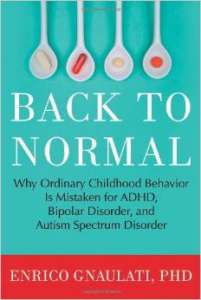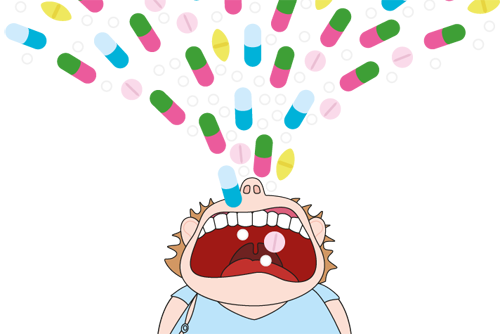 Having spent a sizable enough portion of my own life sitting across from various psychologists and/or psychiatrists, rattling off a series of symptoms in the hopes of gaining some sort of medical clarification, I’m always hesitant to appear skeptical of anyone else’s “official” mental health diagnosis. Becoming a parent hasn’t changed my open-mindedness (for lack of a better word) about these matters; if anything, it has only served to strengthen my understanding of these matters. After all, what if my children should face issues similar to my own (or unique to themselves) at some point? How would I feel if other family members—or friends, or teachers—reacted to whatever their diagnoses turned out to be with a roll of the eyes and an assertion that their potentially debilitating conditions weren’t “real” diseases?
Having spent a sizable enough portion of my own life sitting across from various psychologists and/or psychiatrists, rattling off a series of symptoms in the hopes of gaining some sort of medical clarification, I’m always hesitant to appear skeptical of anyone else’s “official” mental health diagnosis. Becoming a parent hasn’t changed my open-mindedness (for lack of a better word) about these matters; if anything, it has only served to strengthen my understanding of these matters. After all, what if my children should face issues similar to my own (or unique to themselves) at some point? How would I feel if other family members—or friends, or teachers—reacted to whatever their diagnoses turned out to be with a roll of the eyes and an assertion that their potentially debilitating conditions weren’t “real” diseases?
 All of that said, however, I haven’t been able to shake a sense of growing discomfort over the staggering rise in recent years of children diagnosed with such conditions as A.D.H.D., autism spectrum disorder, and even bipolar disorder. According to the Center for Disease Control, there’s been a 41 percent increase in rates of A.D.H.D. over the past decade. In roughly the same time span, bipolar disorder diagnoses became forty times more prevalent, and diagnoses of autism spectrum disorder have increased 78 percent since 2002. Can all of these cases really be legitimate? And if they’re not, what’s driving doctors to over-diagnose our kids?
All of that said, however, I haven’t been able to shake a sense of growing discomfort over the staggering rise in recent years of children diagnosed with such conditions as A.D.H.D., autism spectrum disorder, and even bipolar disorder. According to the Center for Disease Control, there’s been a 41 percent increase in rates of A.D.H.D. over the past decade. In roughly the same time span, bipolar disorder diagnoses became forty times more prevalent, and diagnoses of autism spectrum disorder have increased 78 percent since 2002. Can all of these cases really be legitimate? And if they’re not, what’s driving doctors to over-diagnose our kids?
Back to Normal: Why Ordinary Childhood Behavior Is Mistaken for A.D.H.D., Bipolar Disorder, and Autism Spectrum Disorder (Beacon Press, 2013) by Enrico Gnaulati, Ph.D., offers intriguing (and sometimes disturbing) answers to these questions and more. A clinical psychologist who specializes in child and adolescent therapy and assessment, Dr. Gnaulati has firsthand experience with both the cause and effect of these sometimes questionable diagnoses and does an impressive job of explaining the current crisis, even for readers with little to no background in the subject. This is no easy task, considering how complicated the world of child psychology has become—and how many outside factors ultimately play into the decisions of medical professionals, namely the influence of the pharmaceutical industry, insurance companies, and schools.
There’s been a 41 percent increase in rates of A.D.H.D. over the past decade. In roughly the same time span, bipolar disorder diagnoses became forty times more prevalent, and diagnoses of autism spectrum disorder have increased 78 percent since 2002. Can all of these cases really be legitimate?
According to Dr. Gnaulati, Biederman’s work “redefined” how we think of manic behavior in kids. “Historically, manic behavior has been considered rare, especially in kids,” writes Gnaulati,. “When psychologists like me see it in a person, it can be identified right away. The manic person hasn’t slept for days, believes he or she has inexhaustible energy and superhuman abilities, and, most prominently of all, talks a blue streak. Dr. Biederman redefined manic behavior in kids in terms of irritability, severe tantrums, and rapid mood swings. This looser definition of manic-like behavior heralded a forty-fold increase in the diagnosis of bipolar disorder in youngsters.”
These figures, already dubious, turn alarming when Gnaulati reveals that a Senate hearing in 2008 found Dr. Biederman had received $1.6 million in speaking and consulting fees from “many of the pharmaceutical-industry giants manufacturing antipsychotic medications for use with children thought to have bipolar disorder.”
Most unfortunately, this isn’t the only example of its kind detailed in Back to Normal.
Schools, meanwhile, seem to be placing more and more unrealistic expectations on students—expectations that are coloring teachers’ perceptions of what kids are, and should be, capable of accomplishing. Not that teachers are left with much choice when the amount of funding some schools receive is based on test scores. One study of almost 10,000 seven to eleven-year-olds across the U.S. found that “Students in states where there were stricter academic accountability laws had a greater chance of being diagnosed with A.D.H.D.”
Sadly, there’s little parents can do in the short-term to combat bureaucracy in the healthcare industry or the increasingly strenuous academic demands of most classrooms. We can, however, look at our own attitudes regarding what constitutes “normal” childhood behavior. Naturally, this is trickier than it sounds. Whether or not we realize it, we’re being programmed culturally to question and analyze any and every display of potentially problematic activity by our kids. We can no longer objectively note our three-year-old’s tendency to daydream or our six-year-old’s seemingly endless stores of energy or our 12-year-old’s mercurial mood swings without worrying if perhaps these personality traits aren’t harmless (if challenging) age-appropriate quirks but symptoms of an incipient disorder.
One study of almost 10,000 seven to eleven-year-olds across the U.S. found that “Students in states where there were stricter academic accountability laws had a greater chance of being diagnosed with A.D.H.D.”
Discouraging (if not infuriating), to say the least. So where do the worrying truths revealed in Dr. Gnaulati’s book leave us as parents? As he writes: “As astounding as it may seem, in the doctor’s or therapist’s office, parents may need to steer the discussion about their kid’s problems in the direction of ordinary, commonsense understandings and solutions. Parents may need to wonder aloud whether their kid’s problems are on the far end of normal or are due merely to slower social and emotional maturation. If they do not, parents can be fair game for getting sucked into a juggernaut of mental illness explanations and treatments for their kid’s behavior that, in reality, don’t apply.”
Click here to see Rose’s tips for healthy and happy relationships



